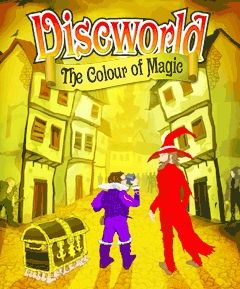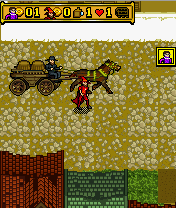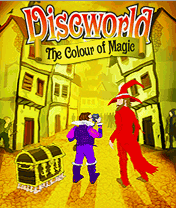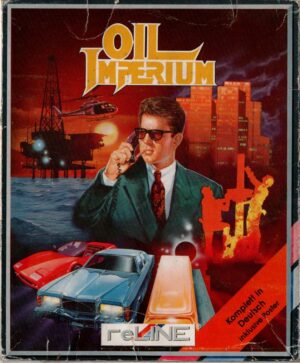Retro Replay Review
Gameplay
Discworld: The Colour of Magic delivers an isometric, adventure-puzzle experience where you only directly control Rincewind, the inept wizard’s apprentice. Your primary goal is to shepherd the wide-eyed tourist Twoflower through 16 interconnected city sections, using a combination of nudges, coin-toss distractions, and a mysterious picture box that temporarily blinds hostile NPCs. Each location forces you to adapt your strategy, whether you’re dodging runaway carriages or coaxing a swamp dragon away from an unsuspecting Twoflower. Timing and careful mapping are essential to keep the duo on track toward their five predetermined sightseeing spots.
Resource management plays a subtle, yet critical role: Twoflower only has a handful of lives, and every misstep can cost you dearly. To tip the scales back in your favor, you’ll search for hidden paint caches to recharge your picture box, and you’ll occasionally get one lifesaving intervention from the voracious Luggage—an all-consuming chest of drawers that can clear a whole screen of threats. These limited tricks keep the gameplay fresh, forcing you to decide whether to conserve or expend your last magical advantage.
While the core mechanics revolve around escorting and evasion, a few light puzzles break up the pacing. Redirecting Thieves, unlocking gates at the Patrician’s Palace, and figuring out the proper moment to unleash the Luggage all provide small bursts of “aha!” satisfaction. However, the linear path and repeated obstacle types can feel a bit routine after the halfway mark, so players seeking deep complexity may find the challenge somewhat modest.
Graphics
Visually, Discworld: The Colour of Magic embraces a colorful, cartoon-inspired pixel art style that captures the whimsy of Terry Pratchett’s universe. The isometric viewpoint offers a clear sense of depth, allowing you to appreciate intricate details in Ankh-Morpork’s winding streets, ominous alleyways, and the imposing façade of the Unseen University. Each of the 16 city sections has its own environmental flair, from the grime of the Whorepits to the solemn stone walls around the Temple of the Small Gods.
Character sprites are expressive, especially Rincewind’s flustered animations and Twoflower’s almost comical wide-eyed wonder. Even minor NPCs—thieves, carriages, street vendors—are given enough personality through subtle frame changes and color shifts to feel part of a living world. The limited palette of early ’90s hardware is used intelligently to differentiate hazard zones from safe paths, and splashes of bright paint in hidden areas add both visual variety and practical utility.
That said, the game’s age is evident in occasional sprite flicker and simplistic background tiling. Modern displays may magnify pixelation or reveal that certain areas lack visual polish. Still, for players who appreciate retro aesthetics, the art direction remains charming and evocative—more than compensating for its technical limitations with genuine Discworld flair.
Story
Based entirely on Terry Pratchett’s debut novel The Colour of Magic, the game follows Rincewind’s ill-fated role as tour guide to Twoflower, the Disc’s first—and wealthiest—tourist. Ordered into service by Lord Vetinari, Ankh-Morpork’s Patrician, this odd couple embarks on a citywide trek that underscores the novel’s satirical take on fantasy clichés. Dialogue appears in text bubbles, capturing the book’s dry wit and absurd humor without fully recreating its razor-sharp prose.
Encounters with trademark Discworld characters—like the all-consuming Luggage and the personification of Death—provide memorable set pieces that fans of the series will instantly recognize. While there’s no voice acting, the written lines are often witty enough to convey character charm, especially when Rincewind’s cowardice bumps against Twoflower’s naïveté. The narrative unfolds in vignettes rather than a continuous cinematic arc, preserving the episodic nature of the source material.
However, the game’s structure can feel episodic to a fault. You’re shuttled from one checkpoint to the next with little connective tissue beyond the map interface. Those unfamiliar with the book might miss some of the deeper jokes or background motivations, and a few story beats land without full emotional payoff. Still, within the constraints of early ’90s adventure design, Discworld: The Colour of Magic succeeds in honoring its literary roots.
Overall Experience
Discworld: The Colour of Magic stands as a nostalgic curiosity—part interactive fan fiction, part puzzle-oriented adventure. It never aspires to be an epic RPG, nor does it deliver deep character progression; instead, it leans into its escort mechanics and comedic scenarios. If you appreciate clever resource juggling, a light dose of strategy, and faithful nods to Pratchett’s zany world, you’ll find plenty to enjoy in its four- to six-hour journey through Ankh-Morpork.
Technical hurdles on modern systems can include outdated resolution support and the need for vintage emulator setups, but community patches and retro-gaming enthusiasts have kept it playable. Multiplayer is nonexistent, and replayability is limited once you’ve memorized the safest routes and puzzle solutions. Yet there’s a simple joy in discovering hidden paint pots or calling in the Luggage at just the right moment—as if tipping your hat to an old friend.
Ultimately, Discworld: The Colour of Magic is best suited for Pratchett aficionados and players who cherish ’90s adventure design. While its linear structure and brief length may not satisfy those craving sprawling modern epics, it offers a compact, humorous trip through one of fantasy’s most beloved settings. For prospective buyers with fondness for retro charm and satirical world-building, it remains a worthwhile detour on the Disc.
 Retro Replay Retro Replay gaming reviews, news, emulation, geek stuff and more!
Retro Replay Retro Replay gaming reviews, news, emulation, geek stuff and more!









Reviews
There are no reviews yet.